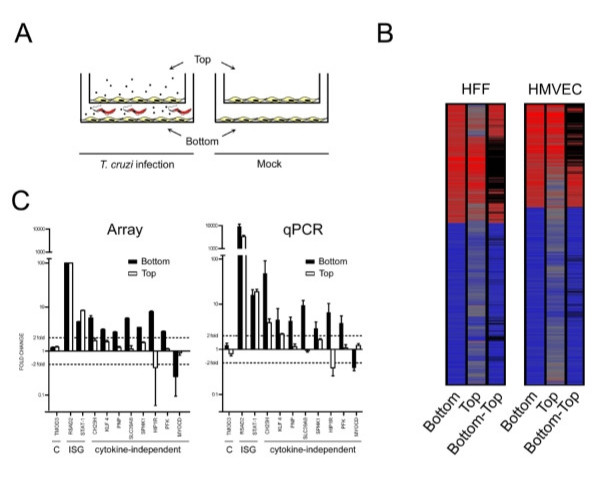Figure 2.
Identification of cytokine-dependent and – independent transcriptional responses in T. cruzi-infected HFF and HMVEC. A. Schematic showing experimental design where T. cruzi-infected cells on the bottom of the transwell plate are separated from uninfected cells on the top layer and mock-infected controls. B. Heat maps showing combined information for two replicate experiments for changes in transcript abundance (≥ 2-fold, p < 0.01) for cells plated in the bottom and top the top Transwell insert and for the genes remaining after subtraction of the genes present in both top and bottom (Methods). Black bars represent cytokine-dependent genes removed by filtering the top response from the bottom. C. qPCR confirmation of microarray data for selected non-differentially expressed genes (C), IFN-stimulated genes (ISG) and presumptive cytokine-independent genes (cytokine-independent) identified by microarray analysis of samples obtained from HFF cells in Transwell experiments. Where more than one sequence corresponding to the same gene was modulated in the microarray data, the perfect match (_at) sequence was chosen. Tropomodulin 3 (TMOD 3), IFNβ (IFN-β), radical S-adenosyl methionine domain-containing protein 2 (RSAD2), signal transducer and activator of transcription 1 (STAT-1), cholesterol-25-hydroxylase (CH25H), kruppel-like transcription factor-4 (KLF4), purine nucleoside phosphorylase (PNP), solute carrier family 39 member 8 (SLC39A8), sphingosine kinase-1 (SPHK1), huntingtin-interacting protein 1-related protein (HIP1R), phosphofructokinase (PFK), myocardin (MYOCD). cDNA generated from three independent infections was analyzed and the mean fold-change ± s.d. are reported for the qPCR.

